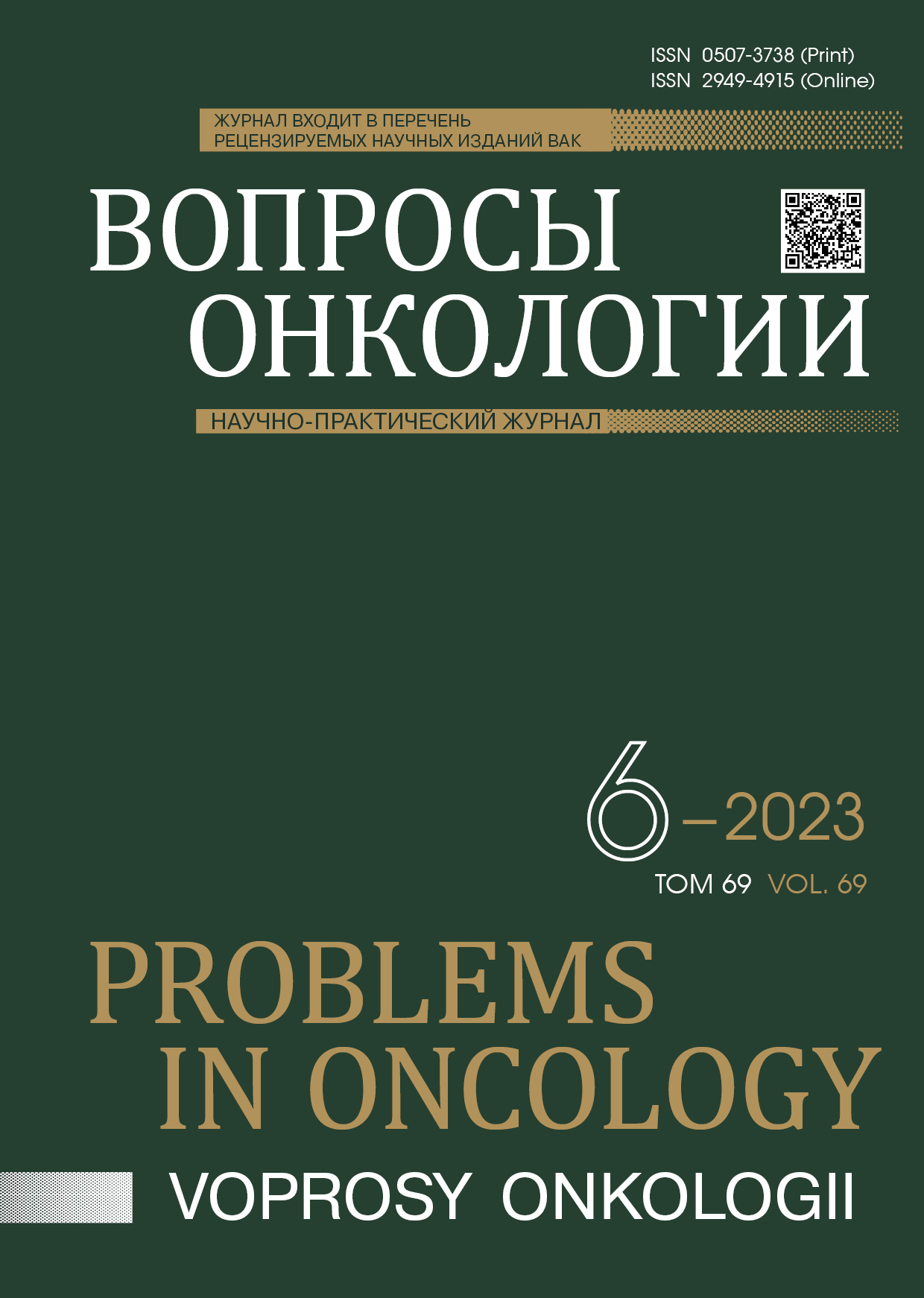Аннотация
Для клинической картины папиллярного рака щитовидной железы (ПРЩЖ) характерны метастазы в лимфатических узлах и, гораздо реже, внутренних органах — легких и костях скелета. Поражение этой опухолью головного мозга описано в единичных наблюдениях или сериях, включающих 5-10 пациентов.
Материалы и методы. По данным Белорусского канцер-регистра за 30-летний период наблюдения из 28 102 пациентов в возрастной группе ≥ 19 лет были идентифицированы 5 мужчин и 6 женщин от 38 до 74 лет к началу лечения ПРЩЖ и один ребенок (девочка) из 1 641 пациентов в возрасте ≤ 18 лет, у которых подтверждены церебральные метастазы на начальном этапе лечения, либо возникшие в процессе послеоперационного ведения.
Результаты. У мужчин заболевание протекало менее благоприятно: по завершению лечения первичной опухоли у них чаще обнаруживали рецидивы/прогрессирование опухолевого процесса (р = 0,003), более низкими были и показатели выживаемости после вовлечения в процесс головного мозга (р = 0,059). К неблагоприятным факторам прогноза можно отнести местную распространенность ПРЩЖ: при рТ3-Т4 значимо чаще были выявлены рецидивы/прогрессирование (р = 0,04) и снижение показателей выживаемости (р = 0,034). У пациентов с отдаленными метастазами отмечен повышенный риск развития рецидива/прогрессирования заболевания (р = 0,027), однако на показатели опухоль-специфической выживаемости наличие органных метастазов не оказало влияния (р > 0,05). Лечебная тактика после диагностики церебральных метастазов значительно разнилась, тем не менее у пациентов, которым проводилась лучевая терапия или радиойодтерапия, самостоятельно или в комбинации с химиотерапией, либо как элемент комплексного лечения, выживаемость была выше (р = 0,022).
Выводы. Представлена подробная клинико-морфологическая характеристика 12 пациентов с церебральными метастазами ПРЩЖ, которые развились после завершения радикального лечения первичной опухоли, стали финалом ее неоднократных рецидивов/прогрессирования, а также наблюдения, где ПРЩЖ дебютировал поражением головного мозга. Сформулированы рекомендации по своевременному выявлению очагов опухоли такой нетипичной локализации: следует включать в план обследования КТ/МРТ головного мозга в случаях распространения карциномы в лёгких и/или костях скелета (на любом этапе заболевания) для своевременной диагностики потенциально летальных интракраниальных метастазов.
Библиографические ссылки
Sung H, Ferlay J, Siegel RL, et al. Global Cancer Statistics 2020: GLOBOCAN estimates of incidence and mortality worldwide for 36 cancers in 185 countries. CA Cancer J Clin. 2021;71(3):209-249. https://doi.org/10.3322/caac.21660.
Hay ID, Thompson GB, Grant CS, et al. Papillary thyroid carcinoma managed at the Mayo Clinic during six decades (1940-1999): temporal trends in initial therapy and long-term outcome in 2444 consecutively treated patients. World J Surg. 2002;26(8):879-85. https://doi.org/10.1007/s00268-002-6612-1.
Pelizzo MR, Boschin IM, Toniato A, et al. Papillary thyroid carcinoma: 35-year outcome and prognostic factors in 1858 patients. Clin Nucl Med. 2007;32(6):440-4. https://doi.org/10.1097/RLU.0b013e31805375ca.
McWilliams RR, Giannini C, Hay ID, et al. Management of brain metastases from thyroid carcinoma: a study of 16 pathologically confirmed cases over 25 years. Cancer. 2003;98(2):356-62. https://doi.org/10.1002/cncr.11488.
Henriques de Figueiredo B, Godbert Y, et al. Brain metastases from thyroid carcinoma: a retrospective study of 21 patients. Thyroid. 2014;24(2):270-6. https://doi.org/10.1089/thy.2013.0061.
Tahmasebi FC, Farmer P, Powell SZ, et al. Brain metastases from papillary thyroid carcinomas. Virchows Arch. 2013;462(4):473-80. https://doi.org/10.1007/s00428-013-1394-4.
Tsuda K, Tsurushima H, Takano S, et al. Brain metastasis from papillary thyroid carcinomas. Mol Clin Oncol. 2013;1(5):817-819. https://doi.org/10.3892/mco.2013.139.
Ha LN, Khanh LQ, Hanh NTM, et al. Screening and treatment of brain metastasis from papillary thyroid carcinoma: a case series. Thyroid Res. 2023;16(1):1. https://doi.org/10.1186/s13044-023-00146-8.
Wu T, Jiao Z, Li Y, et al. Brain metastases from differentiated thyroid carcinoma: a retrospective study of 22 patients. Front Endocrinol (Lausanne). 2021;12:730025. https://doi.org/10.3389/fendo.2021.730025.
Dinneen SF, Valimaki MJ, Bergstralh EJ, et al. Distant metastases in papillary thyroid carcinoma: 100 cases observed at one institution during 5 decades. J Clin Endocrinol Metab. 1995;80(7):2041-5. https://doi.org/10.1210/jcem.80.7.7608252.
Brierley JD, Gospodarowicz MK, Wittekind C, eds. TNM classification of malignant tumours. Wiley-Blackwell, Hoboken. 2016;(8):51-54.
WHO classification of tumours editorial board. Endocrine and neuroendocrine tumours [Internet]. Lyon: International Agency for Research on Cancer. 2022. [cited 2022 Sep 19]. Available from: https://tumourclassification.iarc.who.int/ chapters/36.
Schemper M, Smith TL. A note on quantifying follow-up in studies of failure time. Control Clin Trials. 1996;17(4):343-6. https://doi.org/10.1016/0197-2456(96)00075-x.
Алгоритмы диагностики и лечения злокачественных заболеваний: клинический протокол /Министерство здравоохранения республики Беларусь. Минск: Профессиональные издания. 2019:443-457 [Diagnosis and Treatment Algorithms for Malignant Diseases: A Clinical Protocol. Ministry of Health of the Republic of Belarus. Minsk: Professional Publications. 2019:443-457 (In Russ.)]. Available from: https://pravo.by/document/?guid=12551&p0=W21833500p&p1=1

Это произведение доступно по лицензии Creative Commons «Attribution-NonCommercial-NoDerivatives» («Атрибуция — Некоммерческое использование — Без производных произведений») 4.0 Всемирная.
© АННМО «Вопросы онкологии», Copyright (c) 2023

